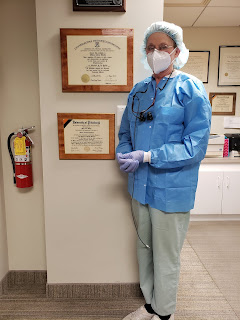The last few weeks have been very hectic! Though we have been open through it all for emergencies, we have found ourselves with a lot of time on our hands. Luckily, there have been many wonderful webinars full of awesome information.
It's never bad to welcome change. To help us service our patients and community in a healthier and safer environment, we are implementing some changes in our office. Here are some precautions we are taking to help fight COVID-19:
1. We ask of patients, if you're having a cough, fever or any symptoms that suggest an illness, stay home! Seek medical assistance.
2. Prior to the pandemic, we went to great lengths to provide a clean and safe environment for our patients. We're taking it a step further! The office is cleaned & disinfected every morning, in between patients and every afternoon. Even if there are no patients seen that day.
 |
| Kat wiping down the front desk counter. |
3. Doctor and staff are wearing facial masks/shields and gloves during every appointment and they're changed after every patient.The Doctor is using KN-95 mask along with an additional mask, as suggested by the CDC, during every treatment. Doctor also wears a gown and hair covering for additional protection.
 |
| Dr. Choby all suited up and ready to serve you. |
3. We understand that sometimes the comfort of a relative or friend is convenient but in order to fight COVID-19 we are limiting the number of individuals in the office. We don't particular have a big office, keeping our distance is challenging. We ask of patients, if possible, to come to their appointments without children and/or other adults.
4. Though we strive to schedule patients without overlapping, it does happen, especially when it's an emergency visit. In these cases, patients are being asked to wait in their cars, if possible, while we complete the current patient's visit and clean & disinfect the op-room & waiting room area.
5. All materials, such as clipboards and pens, are wiped, disinfected and covered with a barrier after every use. Keyboards, computer mouse, x-ray machine, CT scanner handles, anything touched frequently by the Doctor, staff and/or patients, are being wiped, disinfected and covered with a barrier. The front door handles are covered with a barrier that are changed out after every patient.
6. Waterlines are being tested more frequently. A waterline purifier is in the progress of getting placed. Along with a water purifier, an air purifier has been purchased and has been helping with eliminating 99.97% of particles that are being produced in our op-room.
 |
| Pure Enrichment PureZone 3-in-1 HEPA Air Purifier |
 |
| DentaPure DP 365M Water System Purifier. |
Please stay tuned as the days progress, more changes to come.

Comments
Post a Comment